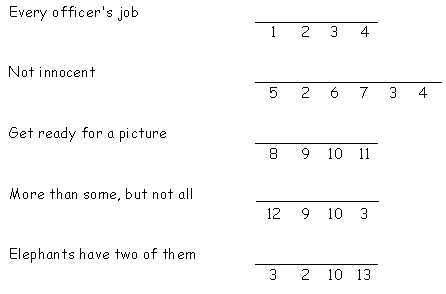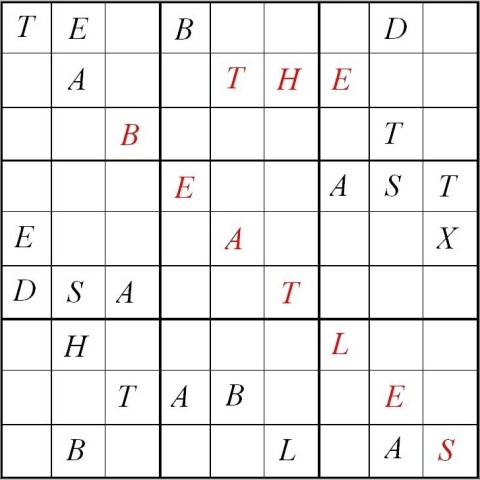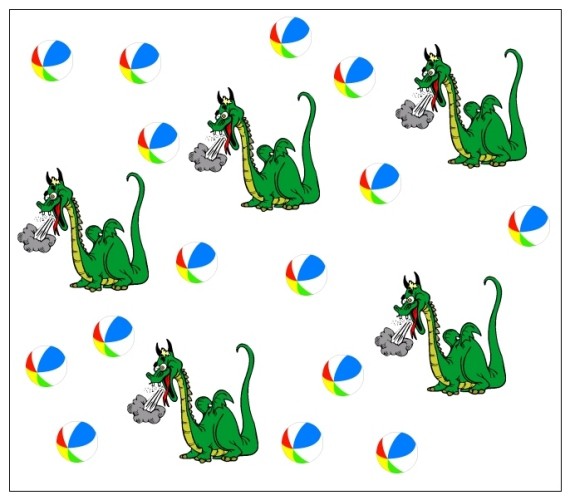Brain Teasers & Puzzles
-
Also known as Hempel’s Paradox, for the German logician who proposed it in the mid-1940s, the Raven Paradox begins with the apparently straightforward and entirely true statement that “all ravens are black.”
The paradox here is that Hempel has apparently proved that seeing an apple provides us with evidence, no matter how unrelated it may seem, that ravens are black. It’s the equivalent of saying that you live in New York is evidence that you don’t live in L.A., or that saying you are 30 years old is evidence that you are not 29. Just how much information can one statement actually imply anyway?
View SolutionSubmit Solution- 1,445.8K views
- 1 answers
- 0 votes
-
Imagine that a farmer has a sack containing 100 lbs of potatoes. The potatoes, he discovers, are comprised of 99% water and 1% solids, so he leaves them in the heat of the sun for a day to let the amount of water in them reduce to 98%. But when he returns to them the day after, he finds his 100 lb sack now weighs just 50 lbs. How can this be true? Well, if 99% of 100 lbs of potatoes is water then the water must weigh 99 lbs. The 1% of solids must ultimately weigh just 1 lb, giving a ratio of solids to liquids of 1:99. But if the potatoes are allowed to dehydrate to 98% water, the solids must now account for 2% of the weight—a ratio of 2:98, or 1:49—even though the solids must still only weigh 1lb. The water, ultimately, must now weigh 49lb, giving a total weight of 50lbs despite just a 1% reduction in water content. Or must it?
Although not a true paradox in the strictest sense, the counterintuitive Potato Paradox is a famous example of what is known as a veridical paradox, in which a basic theory is taken to a logical but apparently absurd conclusion.
View SolutionSubmit Solution- 1,447.5K views
- 1 answers
- 0 votes
-
In his final written work, Discourses and Mathematical Demonstrations Relating to Two New Sciences (1638), the legendary Italian polymath Galileo Galilei proposed a mathematical paradox based on the relationships between different sets of numbers. On the one hand, he proposed, there are square numbers—like 1, 4, 9, 16, 25, 36, and so on. On the other, there are those numbers that are not squares—like 2, 3, 5, 6, 7, 8, 10, and so on. Put these two groups together, and surely there have to be more numbers in general than there are justsquare numbers—or, to put it another way, the total number of square numbers must be less than the total number of square and non-square numbers together. However, because every positive number has to have a corresponding square and every square number has to have a positive number as its square root, there cannot possibly be more of one than the other.
Confused? You’re not the only one. In his discussion of his paradox, Galileo was left with no alternative than to conclude that numerical concepts like more, less, or fewer can only be applied to finite sets of numbers, and as there are an infinite number of square and non-square numbers, these concepts simply cannot be used in this context.
View SolutionSubmit Solution- 1,446.0K views
- 1 answers
- 1 votes
-
Imagine a fletcher (i.e. an arrow-maker) has fired one of his arrows into the air. For the arrow to be considered to be moving, it has to be continually repositioning itself from the place where it is now to any place where it currently isn’t. The Fletcher’s Paradox, however, states that throughout its trajectory the arrow is actually not moving at all. At any given instant of no real duration (in other words, a snapshot in time) during its flight, the arrow cannot move to somewhere it isn’t because there isn’t time for it to do so. And it can’t move to where it is now, because it’s already there. So, for that instant in time, the arrow must be stationary. But because all time is comprised entirely of instants—in every one of which the arrow must also be stationary—then the arrow must in fact be stationary the entire time. Except, of course, it isn’t.
View SolutionSubmit Solution- 1,446.4K views
- 1 answers
- 1 votes
-
To solve the puzzle read the riddle and answer the clues below to find each word. Then place the letters on the lines below. Each letter must be placed on a line marked by the same number. When all the lines are full, the answer to the riddle is revealed. Riddle: What do you get from a pampered cow?


 View SolutionSubmit Solution
View SolutionSubmit Solution- 1,444.4K views
- 1 answers
- 0 votes
-
Find a 4-letter word for each blank below so that when added, two new words (sharing the same middle word) are created. What is each word?
 View SolutionSubmit Solution
View SolutionSubmit Solution- 1,442.9K views
- 1 answers
- 0 votes
-
Here’s a Sudoku challenge with a different spin. Instead of using numbers, the puzzle is made with letters! Can you solve the puzzle so that each of the nine letters are present in each 9×9 grid only once, and also each letter only appears once in each column and row?
 View SolutionSubmit Solution
View SolutionSubmit Solution- 1,444.7K views
- 1 answers
- 0 votes
-
Dorry the Dragon just can’t help himself….he loves beach balls! Unfortunately, beach balls don’t like him much – they tend to pop and loose air. Then they’re not much fun at all. So, can you help Daryl resist his beach ball frenzy? Draw five straight lines through the box below to separate Daryl from the beach balls. When all the lines have been drawn, each section containing Daryl can’t have beach balls in it too.
 View SolutionSubmit Solution
View SolutionSubmit Solution- 1,442.5K views
- 1 answers
- 0 votes
-
Five friends from across the United States planned to meet at a convention in Milwaukee. Each friend came from a different city and each was employed in a different profession. Use the clues to determine the full name of each friend, their home city, and each one’s profession.
- The doctor and Mr. Cross both arrived a day early.
- By coincidence, the secretary from San Diego and the doctor, Ms. Forest, arrived at the hotel together.
- The lawyer arrived late. He was delayed by a case and had to catch a later flight from Baltimore.
- Jane, Mr. Smith, Mark, the mechanic, and the friend from Chicago all planned to spend the weekend after the convention together. Then on Monday, Ms. Trent and Tom would leave to return to work. Dan, the teacher, and Cindy would leave on Tuesday.
- Dan Richards does not live in Baltimore. Cindy does not live in St. Louis.
- Ms. Trent laughed when asked if she was a teacher. “No, he’s from Atlanta,” she said. “I’m from San Diego.”
View SolutionSubmit Solution- 1,443.5K views
- 1 answers
- 0 votes
-
One summer, five couples went on a cruise together for their vacations. The trip lasted for a week and the couples spent most of their time together. Each morning they would meet for breakfast and decide what to do for the day. On the fourth morning however, the ship stopped at a tropical island resort and the couples discovered that everyone wanted to do something different. At length, they decided to split up for the day and meet back on the ship for supper to share their adventures with each other. Being tourists, each couple gave into their urge to bring back a souvenir and by luck, they all brought back something different. Using the clues and the grid below, determine the first and last names of each couple, what they did for the day, and what souvenir they brought back.
- The couple who went scuba diving didn’t buy the homemade candies but loved what Bob and Judy bought.
- Jake, whose last name isn’t Horner, was disappointed by his golfing scores. Peter, who isn’t married to Tracy, wanted to go sight seeing with Bob Gallop but he went surfing with his wife instead.
- Each couple is represented by the following: Mr. and Mrs. Peel, homemade candies, Cindy, Bob, golfing.
- Mike is not Tracy’s husband and Jane is not Ed’s wife. Ed didn’t go hiking.
- The couple who went site seeing bought a beautifully carved wood dolphin at one of the local attractions. The dolphin and Sarah’s model ship were voted the best of the souvenirs.
- Ed, who is not married to Cindy, liked the shirts that Jake Bremmer bought. Mike, whose last name is not Elmwood, bought the postcards.
View SolutionSubmit Solution- 1,443.0K views
- 1 answers
- 1 votes
More puzzles to try-

Couple betrayal puzzle
A couple (say A and B) decided to commit suicide after a rough life. They decided to jump off a ...Read More »
Mystery in the Cabin
There is so small cabin inside a deep forest. All the forest burned out to worst possible but the inside ...Read More »
Inverted playing card puzzle
One fine day, Mr. Puzzle and Mr. Fry were playing cards, but suddenly power went off and they were getting ...Read More »
If 7×7 = 12 puzzle
If 7×7 = 12 5×5 = 8 3×3 = 4 2×2 = 2 Then 6×6 = ?Read More »
Funny and tricky Apple riddle
I have 20 apples and someone ask can you give me 6 apples? How many apples left now with me?Read More »
How did the detective know?
A man was found dead in his study. He was slumped over his desk and a gun was in his ...Read More »
Black & Brown Stuff riddle
Filling these items with black/brown stuff I am sure you will be agreeing Ensures everyone in the office Starts the ...Read More »
Tell the next number
Look at this series: 12, 11, 13, 12, 14, 13, … What number should come next? A. 10 B. 16 ...Read More »
Light the Bulbs Puzzle
There are 100 bulbs in a room. 100 strangers have been accumulated in the adjacent room. The first one goes ...Read More »
In what year did Christmas and New Year’s fall on the same year?
In what year did Christmas and New Year’s fall on the same year?Read More »
You do everyday
Spelled forwards it is what you do everyday, Spelled backwards it is something you hate. What is it?Read More »
Gets dirtier the more you shower riddle
What gets dirtier the more you shower. What is it?Read More »
Think Geometry Riddle
Solve below popular number sequence 314 159 265 358 979 323 846 ?Read More »
The Reunion
Five friends from across the United States planned to meet at a convention in Milwaukee. Each friend came from a ...Read More »
Magical Four Numbers
Find four numbers, the sum of which is 45, so that if 2 is added to the first number, 2 ...Read More »
Arrested before investigation riddle
A man kills his wife and hides the body in some bushes. The next day the police call and say ...Read More »
Two Letters name
My name is two letters. You call many people by this name, but yet their first name is not this. ...Read More »
Is it True?
The following question it puts forth to you: 25 – 55 + (85 + 65) = ? Then, you are ...Read More »
Number Game
This number added to it’s square, and the digits of that summation added together, bring it back to itself. What ...Read More »
More you cut, bigger I grow riddle
The more you cut into me the bigger I grow. What am I?Read More »


